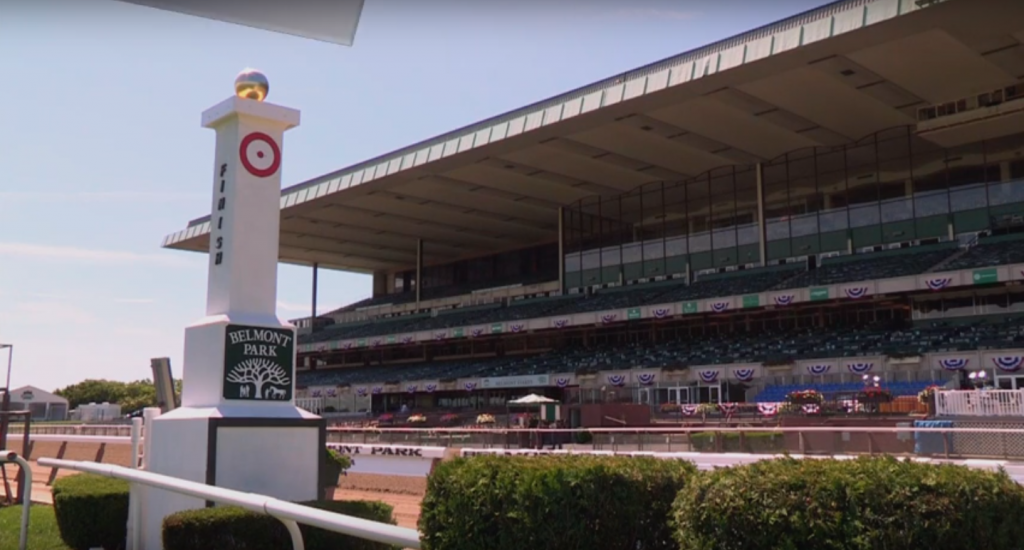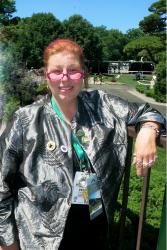There’s a reason Belmont Park is referred to as “Big Sandy”.
Saturday, June 9, 2012: Up to my knees in the deepest sand and dirt I’d ever encountered, I questioned the wisdom of wearing my snazzy loafers with the snaffle bit decorations. Yeah, they were toast. Butch, the sexy-cowboy assistant starter from Laurel, laughed as he made sure that I knew he saw my dilemma and found it humorous.
“Hey, Marion!”
He smirked, but, because Butch has not an ounce of mean in his body, it was a friendly smirk. I acknowledged his amusement and scrambled to keep up with Roy, Elaine and Rumara… but I’m jumping ahead of myself here.

Roy Williamson (photo by Dan Heary).
The story starts on Labor Day, 2011. Roy Williamson, NYRA’s profoundly gifted (and classically handsome) head starter invited me, on closing day at Saratoga, to join him and his wife, Elaine, on the next Belmont Stakes Day.
By “join them”, I mean walking across Belmont’s wide, deep track and standing at the rail on the other side of the starting gate near Roy, when his steely nerves, horsemen’s intuition and one single finger would set off a sonic explosion that could be heard on Mars. (He’d tried to prepare me for the almost oppressive nature of that explosion, but no words would suffice. As he’d said, it’s one of those things that had to be experienced to be believed.)
Roy invited me to stand with the privileged few, at the gate, near the one-hole. Wow.
That sounded like a ton of fun. So, starting that very day, Rumara (my good friend and cousin) and I agreed to meet up at Belmont on the big day the following June — and have a rockin’ good time with Roy, Elaine and 90,000 strangers.
We hung out at a table on the paddock patio at Belmont, starting early in the morning. Being on the patio is rather like being at a wedding reception: people-watching, chatting, greeting colleagues, taking in the vibe and excitement, but with a measure of control.
The patio itself is almost small — small enough, anyway, that I was able to fool myself into thinking there weren’t 90,000 other people milling around. (I am claustrophobic, and a bit of a misanthrope: I could stand in a herd of 90,000 horses and feel quite at home — blissful, even. But standing in the midst of 90,000 human beings… my skin almost starts to itch and I start pawing at my collar as I take on the distressed countenance of Edvard Munch’s subject in The Scream.
When I saw Roy at 7 a.m. that day, he instructed me that Rumara and I should meet him and Elaine immediately after the race prior to the Belmont Stakes had ended. We were to be at the winner’s circle rail, which was tricky to maneuver, but we did it.
The air was electric with excitement, even though I’ll Have Another — winner of the Kentucky Derby and Preakness — had to scratch just the day before due to an injury. With millions of others, I cried as Doug O’Neill announced it. I loved that horse, and really hoped that he’d be the 12th Triple Crown winner.

Belmont Park
Rumara and I hung out just behind the winner’s circle fence for an hour before the pre-Belmont race, ready to pounce when we got the signal from Roy. (By standing there, we had the extreme good fortune to see the serene, beautiful I’ll Have Another as he was paraded out of the paddock, into the chute and, then, into the winner’s circle. He was escorted by his humongous, gorgeous stablemate, Lava Man. I love both horses and shed a few tears that we wouldn’t get I’ll Have Another, Triple Crown Winner. But I felt blessed to be there, at that place and time, to pay homage to two horses that have a special place in my heart.
The reason for us lurking as close as possible to the rail, waiting to pounce when given the signal, was due to the fact that we wanted to avoid getting run over by a herd of race horses. Simple planning would get us all out of the way and safely to the other side of the track.
You see, the Belmont Stakes starts almost at the finish line because, at 1 ½ miles in circumference, Belmont Park is the largest horse race track in America; ergo, the starting gate has to be pulled into place right near the winner’s circle, before the horses hit the track for the Post Parade.
This meant that the four of us — and guests of other bigwigs — had to stand on the inside of that rail as the gate was brought in, and swung around. The minute it was in place, we had to scoot across the track and basically jump into the bushes on the other side. We were told to haul it over there, because we didn’t want to get run over by Paynter, Union Rags or any of the other 1,200-pound athletes who’d be out there with their lead ponies almost immediately.
Hence, my dilemma as Rumara, in sneakers, and I, in loafers, realized that Big Sandy really is big and sandy.
We were shocked to realize that “hauling it” across the track was not a stroll in the park. It was an actual challenge — a scene from a Tarzan movie, in which the naïve English ladies in their wispy dresses get caught in quicksand and make sad faces as they disappear into the Earth.
I was almost up to my knees in muck.
In retrospect, I can understand why Butch was amused as he watched me attempt to trudge through Big Sandy — while holding a purse, tote bag and other unnecessary paraphernalia.
Somehow, though, we made it across the abyss just before the first of the horses blew onto the track.
The key reason for being there was to experience the race from that perspective, of course; but just as important was that Roy had talked with amazement about the physical and emotional effects of the experience.
And he wasn’t talking about the big hats or the singing of “New York, New York” as the horses took to the oval. No, Roy had told me that I absolutely had to experience the “Wall of Sound” that builds like enormous ocean waves, emanating from the 90,000 people in the stands.
It’s one thing to be in the crowd, screaming out, toward the track; it’s another thing altogether to be on the receiving end of that cosmic and very physical Wall.
I’ve been to the Kentucky Derby, in the front row, at the finish line, at the rail. I’ve attended the Belmont Stakes more times than I can count. And I’ve been to every Travers since time immemorial.
But it’s totally different to stand with your back to the source of the sound than it is to be full-on assaulted in the face, chest and heart. To have your organs — which you thought were tucked safely under your ribs — pummeled by such of sound… well, like Roy said, it needs to be experienced to be fully understood.
All sound, including music and the nicker or neigh of a horse — all of it — is physical. We can’t see sound, so we tend to think of it as being a non-physical thing. Be not deceived: we can’t see the wind, either, but certainly we can feel and observe its effects.
If you don’t believe me, try this: take a piece of paper and tape it onto a speaker. Then, put on your favorite tune and crank it up.
Voila! The paper will move and throb with every bang of a drum or thump of an electric bass. The long, strong sound waves of those notes on the deeper end of the music can make that sheet of paper stand straight out.
Sound is physical. And that’s exactly how Roy pitched the invitation to me in 2011 — he told me I absolutely had to come to the Belmont with him and feel the insane power of all those people, screaming their guts out.
He’d told me that, on that one day of the year, he can’t hear himself think. He can’t hear the assistant starter crying, “One out! One out!” All he can do is watch his men interacting with the horses, even as he’s fighting the physical forces of all those people in the stands, attacking him with sound.
The Wall of Sound. How Roy does what he does — did what he did — I cannot fathom. That one experience — from the moment we got to the inside rail until the race had ended — changed something in me forever.
After diving into the bushes, Rumara and I quickly rearranged our clothes, brushed off our shoes and jockeyed for position. The horses were galloping out and getting into the gate. The race was about to begin.
And all the while the sound of 90,000 human spirits screaming rolled toward us like an unstoppable cyclone.
Sound has a way of lulling one into a false sense of safety. When we’d trotted gracelessly across the track, the sound was behind us. But the second we turned and stood, facing the screamers, those sound waves boxed our ears like a gigantic, angry nun.

Union Rags edges past Paynter in the late stages of the 2012 Belmont Stakes (photo courtesy of Marion Altieri).
Then, suddenly, everything went into slow-motion. The sound itself and the physical motions of every living and mechanical thing around us slowed down, like molasses oozing out of a jar.
Roy hit the button to open the gate, the bell sounded, and six tons of horseflesh exploded out of the gate.
Of course, from our limited vantage point, we couldn’t see the race as it unfolded, except on the JumboTron directly behind us. But Union Rags won, sneaking up the rail to defeat Paynter.
Rumara and I talk about that day at least once a year. Always, we try again to plumb the depths of the experience and sort through what we saw, felt and knew. And every time we try, we end up looking into each other’s eyes, shaking our heads in mutual understanding.
Truly, the 2012 Belmont Stakes was the best Belmont ever and Roy’s invitation to share that experience with me was life-changing.
Everyone knows that horses are otherworldly beings. How appropriate that they possess the magical power to take us into their world — to that place where their mere presence inspires humans to unearth previously dormant, terrifyingly perfect, life-altering thunder from within.



